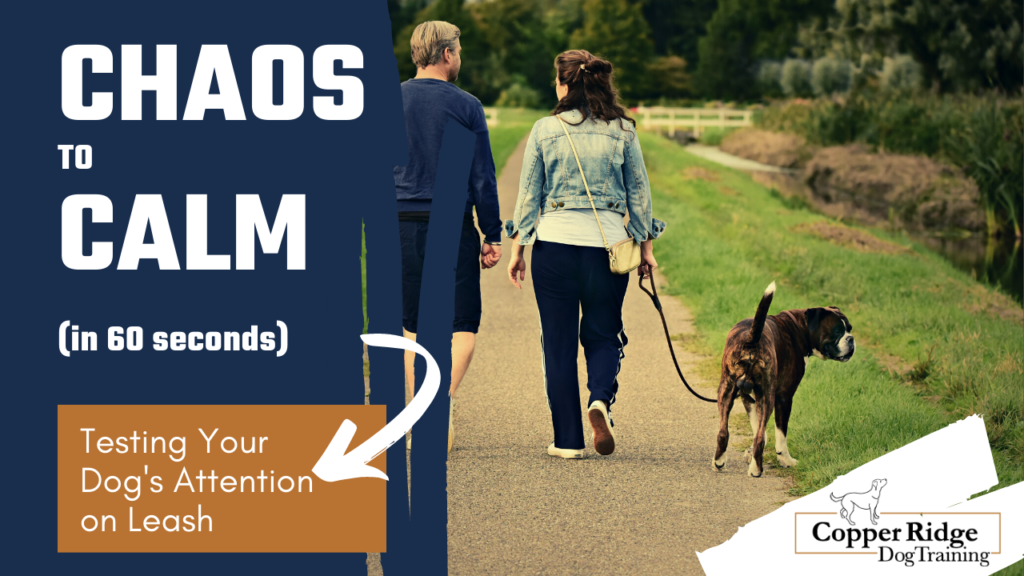
I have yet to have a client approach me and say “Allison, my dog’s leash skills are too perfect. Why isn’t she pulling and barking like all the other dogs?” It just doesn’t happen.
What we typically hear is “My dog pulled me to the ground chasing the neighbor’s cat yesterday,” or “I have to walk my dog at 5am before anyone else is awake, otherwise she loses her mind,” or “I stopped trying to walk my dog because it’s just not worth the stress.”
Walks should be fun for both you and your dog. In an ideal world. But walking calmly on leash is not your dog’s natural instinct, so you need to teach her. And perhaps you’re currently telling yourself “I CAN’T walk my dog,” or “I don’t know how to walk my dog.” Those are normal thoughts when you’re frustrated, but we want to help you shift those thoughts into something more positive. Because we know you can do it.
As you get started on your dog walking journey, we have one easy trick that you can start implementing to see where her attention is, what she is focusing on, and how you can help her pay more attention to you. Sound too good to be true? It’s not!
Step 1: Driveway Drills
Driveway drills! If you are just learning how to walk your dog, I want you to check out this video we created on driveway drills. This skill teaches your dog how to start moving with you rather than pulling against the leash. So take the next 59 seconds to see this lifechanging method in action. This is the foundation that we use with almost every training dog we work with.
Now go out and practice your driveway drills! This truly is step one. We want your dog to learn how to move with you, and how to respond when she’s tight on the leash (hint: it’s not to pull harder). So spend some time on this step before you progress.
Step 2: Go for a Short Walk
Now that your dog understands basic leash pressure and how to move with you, it’s time to go for a short walk. And we mean short. Like, to your neighbor’s driveway and back, short. The reason for this is simple: you and your dog are relearning how to walk on leash together. So don’t bite off more than you can chew too soon, or you’ll both get frustrated. It’s better to do a short path several times than to end up a mile from home, realize neither of you were ready, and fight the entire way home over what the walk will look like.
You may even set a time limit for yourself – the shorter the better. So today, you may say “I’m going to walk my dog for 5 minutes, and then we’re done.” Tomorrow, perhaps you’ll say “I’m going to walk my dog for 7 minutes, but we’re going to play a game of tug in the middle to have some fun.” Setting short time limits for yourself will ensure that you don’t get burnt out, and that both you and your dog want to come back for more. Additionally, there is a lot of learning that can happen in a short period of time wen you’re focused and engaged. So don’t underestimate the power of a short session together.
Step 3: Test Your Dog’s Attention
So you’re walking to your neighbor’s driveway, but you’re not quite sure if your dog is paying you any attention yet. It’s time to test her attention with this one simple trick: whenever you’re ready, take one big step away from your dog. What does she do?
If she’s like most dogs just learning how to walk on leash, she will most likely not care at all that you’ve changed direction. That’s OK – that just tells us that we need to go back to step one and practice driveway drills for a bit to show her how to follow your movement.
But let’s say she notices that you moved away from her, and she closes that gap so that she’s back by your side again. Congratulations! You have a dog that is focused on your movements and understands that she needs to follow you. Tell her she’s a good girl, give her a treat, and keep moving. And tell yourself “I am learning how to walk my dog.”
Now do it again. And again. And again. Each time, you’re building her muscle memory and showing her exactly what to do when she gets too far away from you: close the gap, little pup.
Here it is in action with our training pup, Gemini. Gemini was 6 months old at the time of his training, and came to us jumping and pulling every time he was on a leash. Look at how following these steps can teach even a young, excitable pup how to follow our movements so that both he and his mom can enjoy their walks. And this only took a couple of weeks!
Step 4: Proof Your Dog’s Attention on Leash
As your dog shows you that she really understands this expectation, you’re going to start going on longer walks, but still throwing this little test in to see if she is paying attention. Try doing it around different distractions, as well, like at a busy intersection, or when passing a dog, or at the playground with kids running around. The more you practice it, the easier it will be for her to keep her attention on you while ignoring the world around you.
Step 5: Go Walk Your Dog!
Now it’s time to tell yourself “I CAN walk my dog. I know I can.” Now that you have this skill and you’ve practiced it in lots of different situations (you’ve proofed it), it’s time to get out and start enjoying walks with your dog. Anytime that you notice she’s struggling or not paying attention, just take a big step away from her. Does she ignore your movement (which tells us she’s distracted and not paying attention like she should), or does she close the gap (she’s focused and moving with you). Either way, you’ll gain valuable insight into where her head is at, and you can help her accordingly.
Conclusion
Walks with your dog should be fun. We want you to have adventures and experiences together. We want you to confidently say “I can walk my dog anywhere!” and actually believe that it will be a fun walk. In order to get to that point, however, you need to put in some work to teach her how to be the best walking companion there is. That means practice. And practice a lot. You’ll be so glad you did.
Want to take your leash skills to the next level? Check out our blog post: Leash Skills: Does My Dog Always Have to Walk in a Heel? This is a great next step for adding even more fun and freedom into your walks together.
